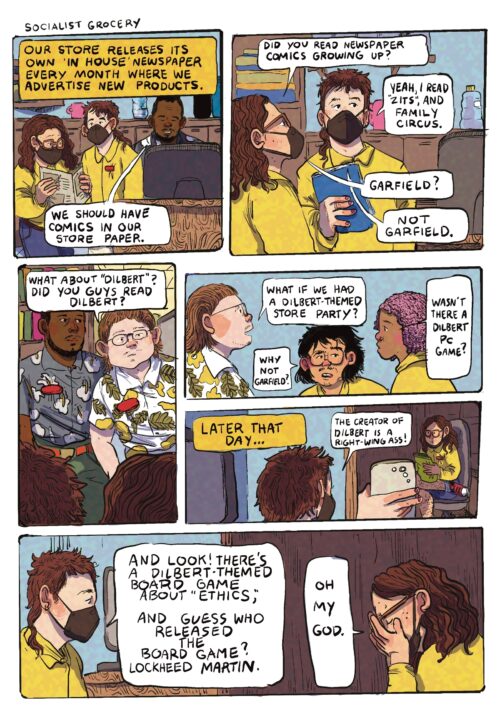Post by Colette Copeland
I was still thinking about David Lynch’s lecture on consciousness and creativity when I visited the Rodney Graham exhibit at the ICA. (See my Lynch post)
Lynch attributes his unique (a.k.a. macabre) vision and ideas to his 2x/day TM practice. Conceptual Vancouver artist Rodney Graham also seeks to expand his consciousness, but through means at odds with Lynch’s approach. In lieu of a disciplined, organic practice, Graham uses synthetic chemicals to alter his brain chemistry. In his retrospective, Graham explores optics and perception, readily admitting to being ‘under the influence’ while creating some of his film and video pieces.
(for another take on Graham, see Libby’s post)
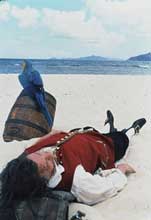
When I took a class of students to the exhibition last week, a few expressed outrage over his blatant drug use, which they alleged as condoning (even celebrating) illegal behavior. I wondered why Graham chose to ‘confess’ his drug use in the wall text of the museum. Is that knowledge intrinsic to the understanding of Graham’s work? Even after viewing the work several times, it was not obvious that Graham was under mind-altering substances. Since perception is a recurring theme in Graham’s work, the drugs seem to function as an experimental strategy in altering or transforming insight and creativity. (image is Graham’s “Vexation Island,” a video loop in whichthe artist gets repeatedly konked on the head by a coconut when he wakes up from being previously knocked unconscious and –forgetting himself — shakes the coconut palm tree again triggering another nut to fall on him.)
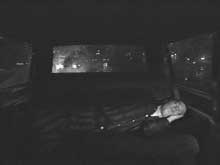
For the 1994 video, “Halcion”, Graham ingests a large does of the tranquilizer Halcion (known for inducing deep dream states). Friends removed his sleeping body from a hotel room in Vancouver and placed him in a taxi, which then drove him to his apartment in the city center. The video features a comatose Graham, dressed in comical, striped pajamas, peacefully slumbering in the backseat of the cab. (image. And see the video here.)
The journey is both real and metaphoric; Graham travels through his consciousness into the deep recesses of his memory, not privy to the viewer. The camera’s vantage point places the viewer inside the taxi with Graham—we become the voyeur watching Graham sleep. On display next to the video is a glass case containing the striped pajamas. Do the pajamas authenticate the experience or point to the artificiality of the film world? I wonder if this is a real or simulated ‘trip’. (Pun intended)
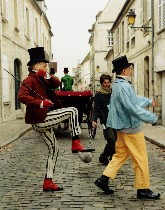
Graham created, “Coruscating Cinnamon Granules” (1996) while on acid. Are we to believe that the magic occurring in this lovely black and white16mm film would be absent without a hallucinatory-inspired experience? In a darkened room, sudden bursts of light appear on the screen, resembling shooting stars or fireflies on a humid, summer night. The abstraction reminds me of early Lazlo Moholy-Nagy’s photographic experiments with light and movement. As the film progresses, we suddenly see the outline of interlocking circles revealing a coil. The shape references Robert Smithson’s famous land artwork, “Spiral Jetty”. In the gallery notes, Graham refers to Marcel Duchamp’s “Rotorelief” and to Smithson’s Spiral Jetty. Is he concerned that the viewer will dismiss the work as merely the product of an LSD trip, feeling compelled to legitimize the film with important art historical references? (image is Graham’s “City Self Country Self”)
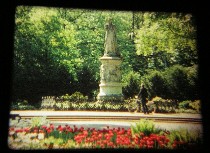
Quoting Graham, who says, “My point is, the trip is the thing” perfectly summarizes the experience of the 16mm film “The Phonokinetoscope” (2002). Loud stoner music reminiscent of Pink Floyd blares as the viewer enters the dimly lit room. In one corner sits a record player, with instructions on how to lift and lower the needle. At the other end of the room, an old film projector hums as the film plays, depicting Graham on a bicycle trip. (image is film still from Graham’s trippy bike trip)
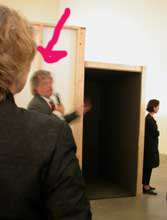
According to Graham’s ‘cliff’ notes, the film references Albert Hoffman’s 1943 inaugural bike trip on acid. In homage to Hoffman, the inventor of LSD, someone produced Hoffman acid tabs, which picture the man on his bike. Apparently this brand was unavailable, so Graham had to make do with ‘Mad Hatter’ acid. The artist also cites the Syd Barrett documentary film, which depicts the first acid trip on a bike byhttp://www.blogger.com/img/gl.link.gif the 19yr old Barrett. Graham also composed and performed the soundtrack to “The Phonokinetoscope”. (image is Graham speaking and gesticulating at the opening. Pardon my wiggly arrow.)
I’m not sure if Graham’s intent was to create a hallucinatory environment for the viewer through the music and film. Since he is the film’s subject and not the cinematographer, the viewer does not have access to the altered state of consciousness. Graham carefully storyboarded the film and his sketches are on display in the room. So what is the point of the acid trip, beyond citing his ‘tripping’ predecessors?
As for expanding consciousness and creativity, I personally prefer the safer and legal organic methods.
—Colette Copeland is a video installation artist and a regular contributor to artblog.
graham, rodney






